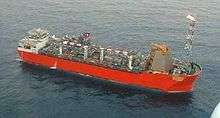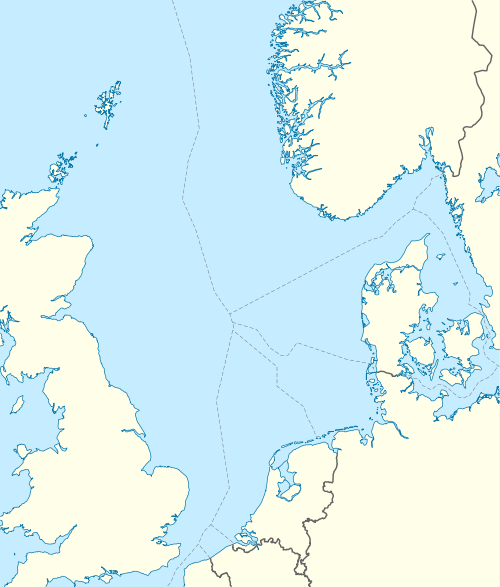Schiehallion oilfield
| Schiehallion oil field | |
|---|---|
 Schiehallion Vessel 2004 | |
 Location of Schiehallion oil field | |
| Country | Scotland, United Kingdom |
| Region | North Sea |
| Offshore/onshore | offshore |
| Coordinates | 60°20′N 4°20′W / 60.333°N 4.333°WCoordinates: 60°20′N 4°20′W / 60.333°N 4.333°W |
| Operator | BP |
| Partners | BP, Shell, Amerada Hess, Murphy Oil, Statoil, OMV |
| Field history | |
| Discovery | 1993 |
| Start of production | 1998 |
The Schiehallion oilfield is a deepwater offshore oilfield approximately 175 kilometres (110 mi) west of the Shetland Islands in the North Atlantic Ocean. The Schiehallion and adjacent Loyal field were jointly developed by BP on behalf of the Schiehallion field partners; BP, Shell, Amerada Hess, Murphy Oil, Statoil and OMV, and the Loyal field partners; BP and Shell.
The Schiehallion field, together with Foinaven, Clair, Lancaster and Solan fields, forms the frontier area generally termed as the West of Shetland.
Field development
Schiehallion field was discovered in 1993 by the semi-submersible drilling vessel Ocean Alliance while drilling the third exploration well in block 204 (well 204-3). The field is located in blocks 204/20 and 204/25 of the United Kingdom Continental Shelf in a water depth of 350 to 450 metres (1,150 to 1,480 ft). Recoverable oil reserves of Schiehallion are estimated to be between 450 and 600 million barrels (72×106 and 95×106 m3).[1][2]
During 1994 and 1995 an appraisal of Schiehallion and Loyal was carried out, culminating in a successful extended well test, which demonstrated well rates of up to 20,000 barrels per day (3,200 m3/d). The combined development of the Schiehallion and Loyal fields was sanctioned in April 1996 and the oil production started on 29 July 1998.[1]
The design and construction of the Schiehallion FPSO vessel was contracted to the Atlantic Frontier Alliance, an ad hoc contracting consortium consisting of Harland and Wolff, SBM Offshore, and Brown and Root.[3] The vessel was designed as a simple barge form, with a 245-metre (804 ft) length similar to a Suezmax tanker. The contract was placed in June 1995. The vessel was constructed at the Harland and Wolff shipyard in Belfast, and handed over to operator BP on 31 December 1997. The vessel has a dead-weight of 154,000 tonnes (152,000 long tons; 170,000 short tons), a processing capacity of 200,000 barrels per day (32,000 m3/d), and a storage capacity of 900,000 barrels (140,000 m3).[2]
Oil and gas are produced from subsea wells via manifolds and rigid flowlines to a location underneath the vessel. From this point, flexible risers carry the production stream to the Schiehallion FPSO vessel. There are 42 subsea wells in total in five clusters with peak production rates of around 190,000 barrels per day (30,000 m3/d).[1]
Oil is exported primarily to the Sullom Voe Terminal by the dynamically positioned shuttle tanker Loch Rannoch delivered in August 1998, and operated by BP Shipping.[4]
Produced natural gas is partly used to power the vessel. The rest of the gas is exported through the West of Shetland pipeline to the Sullom Voe Terminal. Some of the exported gas is used as fuel in the Fortum operated Sullom Voe power station. The remainder is enriched with liquefied petroleum gas and exported to the Magnus platform for enhanced oil recovery in Magnus field.[1]
After more than a decade working in the harsh North Atlantic, the Schiehallion FPSO is in a poor condition, and requires significant maintenance and repairs, which can only be performed in the summer season because of the hostile weather in the region. The increased water production is affecting the composition of the production fluids, and the FPSO processing system is becoming very constrained by the high water volume. As a consequence, Production was suspended at the start of 2013 to allow preparation for a £3 billion redevelopment of the greater Schiehallion field area. A state-of-the-art FPSO, (the Glen Lyon), brand-new seabed infrastructure and world-leading subsea technology will play a major part in the redevelopment of these fields, as will the use of a new enhanced oil recovery scheme. Due to come onstream in 2016, the redevelopment will extend production from the hub beyond 2035. The Schiehallion and Loyal fields have produced nearly 400 million barrels of oil since production started in 1998 and an estimated 450 million barrels of resource is still available, more than was originally thought.[5]
See also
References
- 1 2 3 4 "The Schiehallion Field" (PDF). BP. Retrieved 2009-12-19.
- 1 2 "Schiehallion Oil Field, United Kingdom". Hydrocarbons Technology. Net Resources International. Retrieved 2008-02-16.
- ↑ MacGregor, J. (2001). "Experience of a UK Shipyard in the 1990s Offshore Market" (PDF). The Royal Institution of Naval Architects: 10. Retrieved 2009-12-19.
- ↑ "Loch Rannoch Shuttle Tanker". BP. Retrieved 2009-12-19.
- ↑ Beckman, Jeremy (2013-08-08). "BP looking to maximize production from Shetland area fields". Offshore Magazine. Retrieved 2013-10-25.
External links
| Wikimedia Commons has media related to BP FPSO Schiehallion (ship, 1998). |